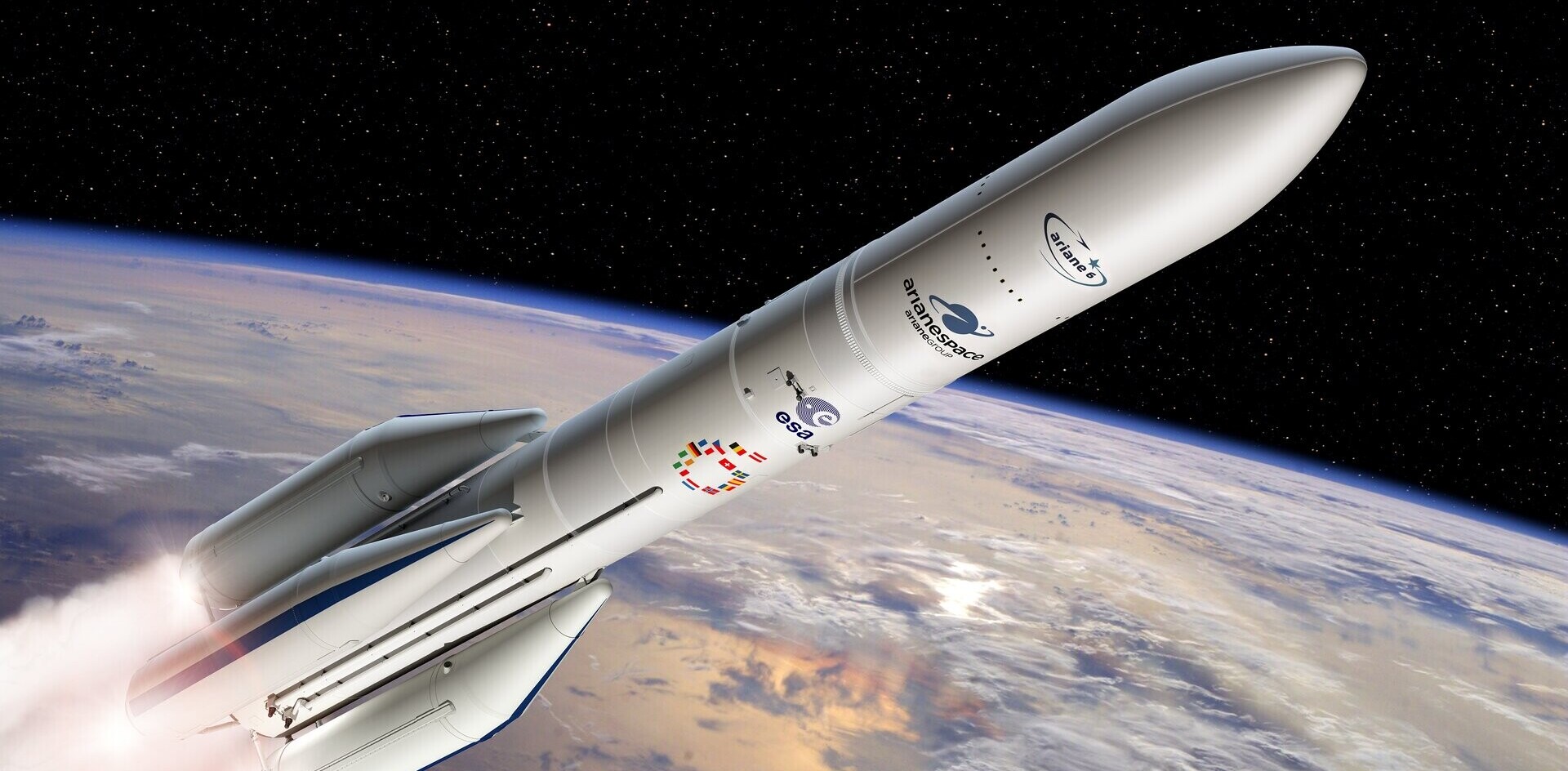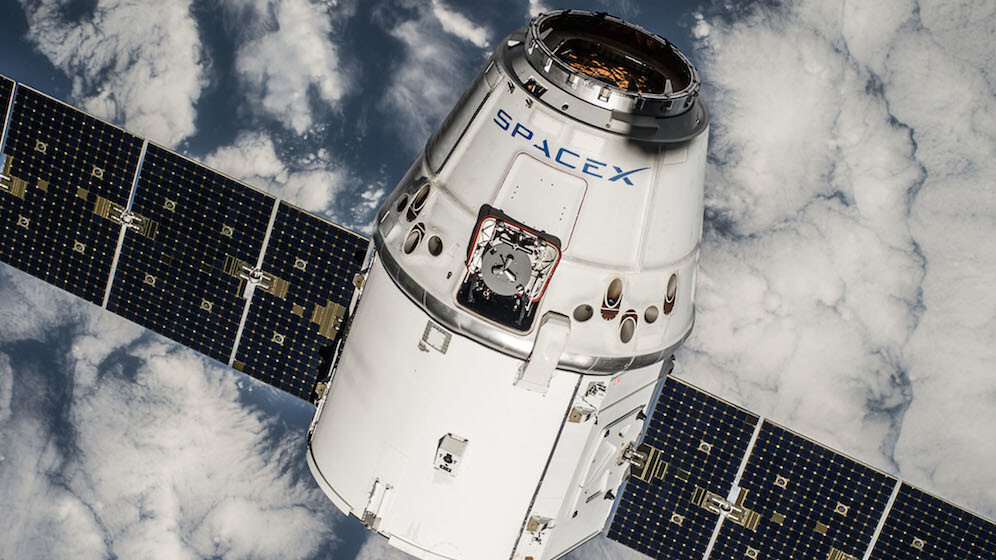
In a battle between billionaires, Blue Origin and SpaceX are leading the pack to make commercial space travel viable for future generations.
However, in the incredibly costly and difficult task of space travel, the path to success is founded on small advances. Are Blue Origin and SpaceX truly competitors or are they vying for different goals? Despite the uncertainty of each company’s long-term ambitions, one thing is for sure; it’ll be a great ride.
The vision to colonize space has sparked the imagination of humans for centuries and now seems more than ever the opportune time to make it a reality. Professor and astrophysicist Stephen Hawking recently explored humanity’s place on Earth and beyond, suggesting our hospitable time on Earth may be limited.
Although the chance of a disaster to planet Earth in a given year may be quite low, it adds up over time, and becomes a near certainty in the next thousand or ten thousand years. By that time we should have spread out into space, and to other stars, so a disaster on Earth would not mean the end of the human race. However, we will not establish self-sustaining colonies in space for at least the next hundred years, so we have to be very careful in this period. – Stephen Hawking, BBC Interview
From books to rockets
Jeff Bezos, the billionaire founder of Amazon, started Blue Origin from a childhood dream to make spaceflight affordable to the general population.
Bezos has a knack for step changes in his businesses, from selling books out of his garage, to selling apps and toys around the world, to starting a human spaceflight startup.
Much of Blue Origin’s mission is centered on popularizing space travel with an end goal of colonizing other planets. Bezos has invested some of his own $46.7 billion net worth to make this goal a reality.

However, Blue Origin is testing on a smaller scale what it hopes to accomplish down the road on a larger scale. Blue Origin is working on the larger BE-4 as they upscale their technology to efficiently carry both passengers and cargo to space.
Blue Origin’s goal lies primarily in reusable and relatively cheap transportation of humans to space. “We are building Blue Origin to seed an enduring human presence in space” notes Blue Origin on their historic first landing of New Shepard. Blue Origin plans to build a $200 million space launch and facility on Florida’s coast.
Despite active development, Bezos and Blue Origin have remained secretive about its rocket launches and future plans.
A dream to colonize Mars
Elon Musk has made it clear that his mission with SpaceX is to colonize Mars and to help humanity become a multi-planet species.
Musk started SpaceX 14 years ago after selling his share of PayPal and in conjunction with starting Tesla Motors. Musk’s motivation for multi-planet colonization derives from a concern over the future of the human species and the Earth we live on. Much like Stephen Hawking’s aforementioned concern, Elon believes we must expand beyond the reaches of Earth, or go extinct.
An asteroid or a super volcano could destroy us, and we face risks the dinosaurs never saw: an engineered virus, inadvertent creation of a micro black hole, catastrophic global warming or some as-yet-unknown technology could spell the end of us. Humankind evolved over millions of years, but in the last sixty years atomic weaponry created the potential to extinguish ourselves. Sooner or later, we must expand life beyond this green and blue ball — or go extinct. – Elon Musk
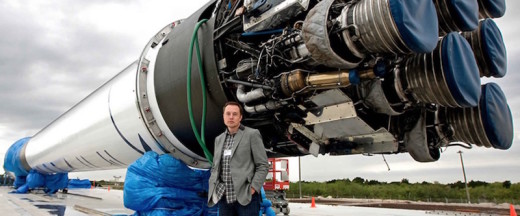
With this reduction in cost, Musk sees Mars colonization in the 2040 timeframe with a population up to 80,000. However far we are from that now, SpaceX is working toward cargo delivery and building the framework for colonization on Mars.
Orbital vs. suborbital space flight
When comparing Blue Origin to SpaceX it is necessary to understand that both have very different criteria for success. A success criterion for Blue Origin is to launch rockets into sub-orbit while the success criteria for SpaceX is to launch rockets into orbit.
Orbital space flight requires the object to be launched into Earth’s orbit and is required to stay at orbital velocity, roughly 17,400 mph at a 200km circular orbit. If the rocket’s trajectory is not sufficient to send it into orbit, gravity will begin to bring down the vehicle.
On the other hand, suborbital flight is any flight where the vehicle reaches a maximum velocity below the orbital velocity. Hence, gravity will act on the vehicle, bringing it back to Earth’s surface. Suborbital flight maxes out at 62.5 miles altitude, beyond which orbital flight would begin.
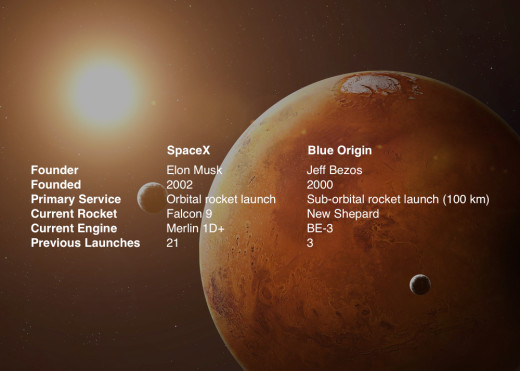
The flight speed required to achieve a 100 km altitude is 950 m/s, whereas orbital velocity is eight times faster at 7,780 m/s. This significant difference in flight speed impacts the vehicle design, size, mass, and engine power.
Falcon 9’s first stage vehicle reaches twice the height of New Shepard at 200 km compared to 100 km. Therefore, Falcon 9’s first stage reaches up to Mach 7.5 as compared to New Shepard’s Mach 3 velocity.
Missions of different scale
Both Blue Origin and SpaceX are trying for a reusable rocket where the first stage lands safely after being used.
Blue Origin has successfully launched and landed their New Shepard rocket three times and SpaceX has stuck two landings – one at sea and one on land. However, to compare the two is to deny the fact that they are very different missions on very different scales.
Since the New Shepard is meant to transfer humans to sub-orbital space for a few minutes and then fall back down, the rocket can be short and wider than what is required on the Falcon 9 rocket. To launch payloads and satellites to the ISS, the Falcon 9 must be tall and thin. In fact, the two rockets are completely different in design and intent.
The New Shepard is designed to send a single crew capsule up to 100 km for several minutes only to fall back to Earth. Meanwhile, SpaceX’s Falcon 9 is built to bring payloads to orbit, requiring approximately four times the thrust power as seen below.
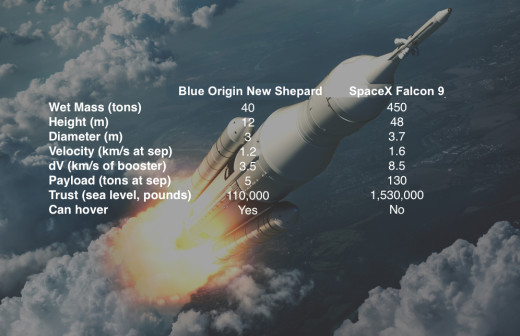
The two vehicle also differ in the use and number of engines to launch, modify trajectory, and land.
The New Shepard contains a launch burn to lift the vehicle to 100km and a landing burn to slow down the return velocity. While, the Falcon 9 contains the same launch and land burn, but also requires a boost back burn to reverse the velocity of the vehicle and bring it back to Earth. It also requires a separate re-entry burn at 70 km to slow the vehicle’s velocity before it reaches the lower atmosphere.
The landing mechanism for the New Shepard and the Falcon 9 also differ. The New Shepard BE-3 engine has the unique ability to throttle down to 40 percent, which means the vehicle can almost hover while landing, affording it the advantage of more time to line up with the launch platform.
In comparison, the Falcon 9 uses the Merlin 1D, which can only throttle down to about 65 percent. Therefore, the Falcon 9 cannot hover while landing but must reach zero velocity at the exact time the rocket touches the launch pad or else it will begin to rise again. This difference makes a Falcon 9 landing much more difficult and the need for incredibly accurate and precise movement a necessity.
Trajectories and missions of Blue Origin and SpaceX are quite different.

Asynchronous yet parallel goals
Despite the many comparisons made of late between Blue Origin and SpaceX, many must be made with an asterisk. Both companies are clear that their end goal is to colonize space, however their tactic remains vastly different.
One can draw comparisons of the colonization of the United State’s western frontier with colonization of Mars, in a very generalized sense. Rapid movement of people and materials west was not possible until a greater Transcontinental Railroad was constructed in 1869 to connect cities to the frontier. Both SpaceX and Blue Origin will build the framework and foundation for space colonization, a foundation that depends on regular and frequent supply routes.
Therefore, despite the inclination for comparison, Blue Origin and SpaceX are two engines of space colonization. Both are necessary to build the foundation of a multi-planet species and we thankfully have a front row seat.
Read next: Elon Musk has an idea for an electric plane that can take off vertically
Get the TNW newsletter
Get the most important tech news in your inbox each week.

